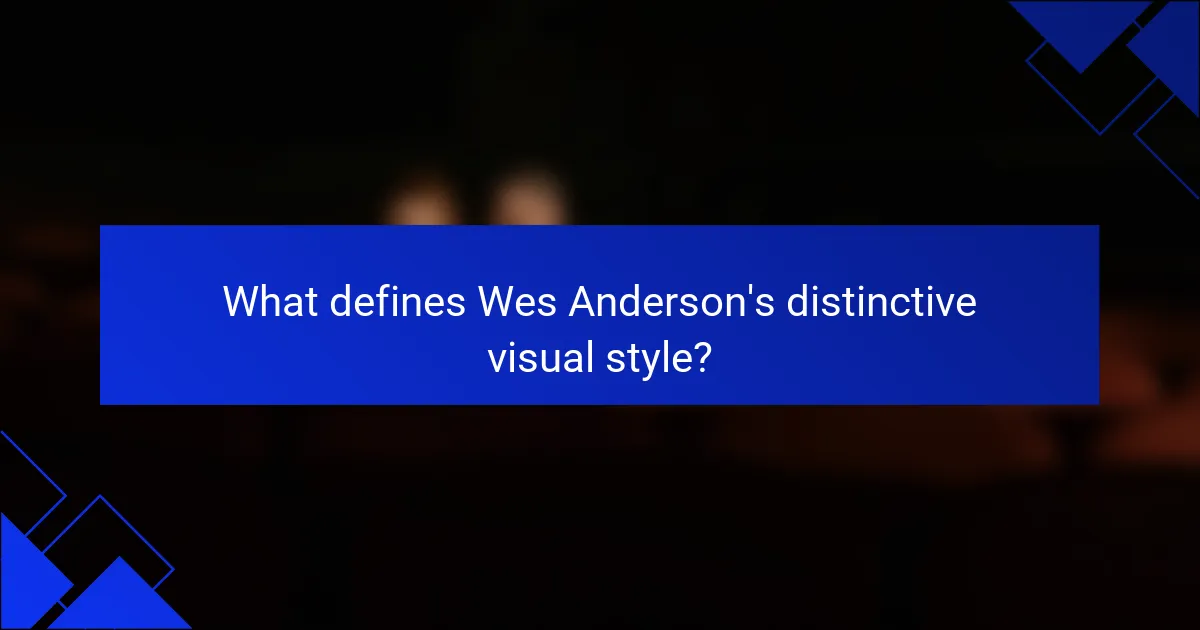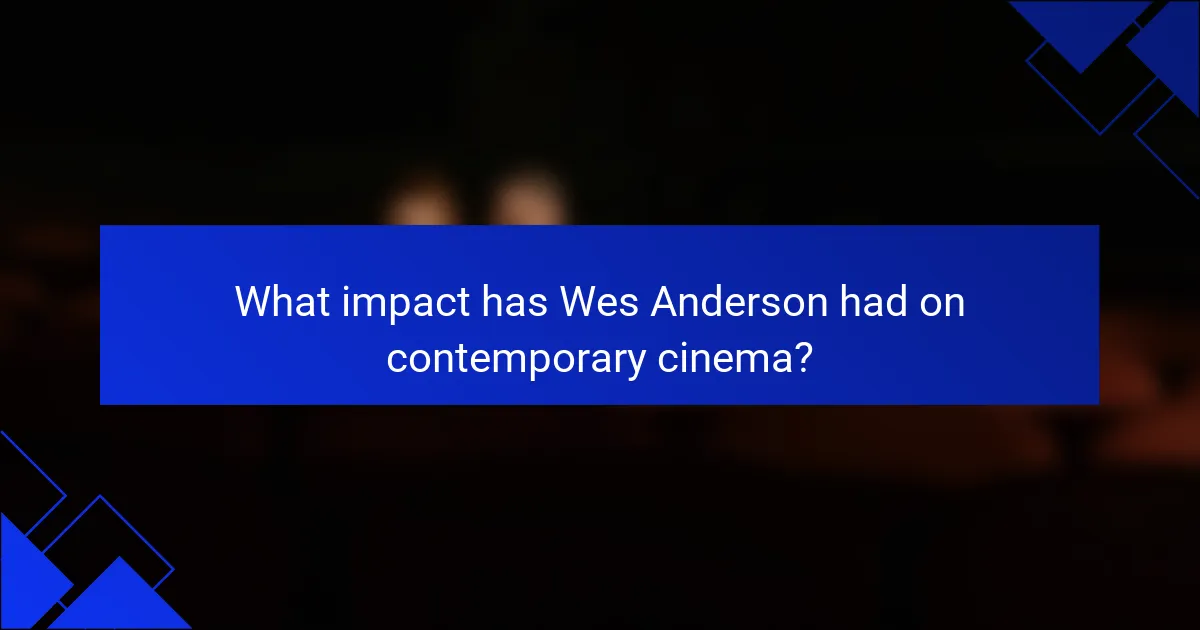
What defines Wes Anderson’s distinctive visual style?
Wes Anderson’s distinctive visual style is defined by its meticulous symmetry and vibrant color palettes. His films often feature highly stylized sets that resemble dioramas. This unique approach creates a whimsical, storybook quality. Anderson employs a fixed camera perspective, enhancing the theatricality of each scene. His use of pastel colors contributes to a dreamlike atmosphere. Additionally, he incorporates detailed costumes and props that reflect character traits. The framing of shots often resembles a painting, emphasizing composition. This visual language has become a hallmark of Anderson’s filmmaking, influencing contemporary cinema.
How does color play a role in Wes Anderson’s films?
Color in Wes Anderson’s films serves as a crucial element for visual storytelling. It creates distinct moods and enhances character development. Anderson employs a vibrant color palette, often featuring pastel tones and bold contrasts. This choice establishes a whimsical atmosphere that is characteristic of his style. Each color scheme is meticulously planned to reflect themes and emotions within the narrative. For instance, “The Grand Budapest Hotel” uses pinks and purples to evoke nostalgia and warmth. The strategic use of color also aids in differentiating characters and settings. Overall, color is integral to the aesthetic and emotional depth of Anderson’s films.
What are the predominant color palettes used by Wes Anderson?
Wes Anderson predominantly uses pastel color palettes in his films. His signature style often features soft pinks, muted greens, and warm yellows. These colors create a whimsical and nostalgic atmosphere. In addition, he frequently employs complementary color schemes. For instance, contrasting colors like blue and orange are common. This approach enhances visual interest and depth. Anderson’s color choices are deliberate and contribute to storytelling. The palettes evoke specific emotions and set the tone for each scene. His films, such as “The Grand Budapest Hotel,” exemplify these color strategies effectively.
How do color choices influence the mood of his films?
Color choices significantly influence the mood of Wes Anderson’s films. His use of vibrant, saturated colors creates a whimsical and nostalgic atmosphere. For instance, the pastel color palette in “The Grand Budapest Hotel” evokes a sense of charm and fantasy. Darker hues, like those in “The Royal Tenenbaums,” convey melancholy and introspection. Anderson often employs color symbolism to enhance emotional depth. For example, warm colors can signify comfort, while cool tones often reflect sadness. His meticulous color coordination contributes to the overall storytelling, reinforcing themes and character emotions. The consistent application of these techniques establishes a unique visual identity that resonates with audiences.
What is the significance of symmetry in Wes Anderson’s filmmaking?
Symmetry is a defining characteristic in Wes Anderson’s filmmaking. It creates a sense of order and visual harmony. This technique enhances the storytelling by guiding the viewer’s focus. Symmetrical compositions often reflect the emotional state of characters. For instance, in “The Grand Budapest Hotel,” symmetry emphasizes the meticulousness of the hotel and its staff. The use of symmetry also contributes to the whimsical and stylized aesthetic of his films. It reinforces themes of nostalgia and childhood wonder. Anderson’s deliberate framing invites audiences into a meticulously crafted world. Overall, symmetry plays a crucial role in shaping the unique visual language of his work.
How does symmetry affect the composition of scenes?
Symmetry significantly influences the composition of scenes in visual storytelling. It creates a sense of balance and harmony. Symmetrical compositions often draw the viewer’s eye to the center of the frame. This technique can evoke feelings of order and stability. In Wes Anderson’s films, symmetry is a hallmark of his distinctive visual style. He frequently uses centered compositions to enhance the whimsical nature of his storytelling. Research indicates that symmetrical images are perceived as more aesthetically pleasing. This perception can enhance viewer engagement and emotional response.
What are examples of symmetry in specific films?
Wes Anderson frequently employs symmetry in his films to create visual harmony. In “The Grand Budapest Hotel,” symmetrical compositions enhance the whimsical aesthetic. The hotel itself is designed with a balanced layout, reflecting the film’s themes of order and chaos. In “Moonrise Kingdom,” the framing of characters in the forest showcases symmetrical visuals that underline their emotional connection. “The Royal Tenenbaums” features symmetrical shots of the family home, emphasizing the characters’ relationships and their shared history. Each instance of symmetry reinforces the narrative and visual storytelling unique to Anderson’s style.
How does Wes Anderson utilize set design and props?
Wes Anderson utilizes set design and props to create a distinct visual style. His films feature meticulously crafted environments that enhance storytelling. Each set is rich in detail, often resembling dioramas or storybook illustrations. Props are carefully chosen to reflect character traits and themes. For instance, in “The Grand Budapest Hotel,” the hotel itself acts as a character. Anderson employs a vibrant color palette to evoke emotion and nostalgia. He often uses symmetry and geometric shapes in his designs. This approach creates a whimsical atmosphere that captivates audiences. The intentional use of props and set design reinforces the unique narrative style of his films.
What unique elements are often found in his set designs?
Wes Anderson’s set designs often feature symmetrical compositions. This symmetry creates a sense of order and balance. His sets are characterized by vibrant color palettes. These colors contribute to the whimsical atmosphere of his films. Additionally, Anderson incorporates intricate details in props and backgrounds. These details enhance the storytelling and visual richness. Unique architectural styles are also prevalent in his designs. They often reflect a nostalgic or storybook quality. Overall, these elements combine to create a distinct visual identity in his films.
How do props contribute to storytelling in his films?
Props in Wes Anderson’s films serve as crucial storytelling devices. They enhance visual storytelling by adding depth to characters and settings. Each prop is meticulously chosen to reflect the film’s unique aesthetic. For instance, the use of vintage items often evokes nostalgia. This nostalgia supports the emotional tone of the narrative. Additionally, props can symbolize themes central to the story. In “The Grand Budapest Hotel,” the hotel itself acts as a character, representing lost grandeur. Overall, props in Anderson’s films enrich the narrative experience by providing context and emotional resonance.

What are the key elements of whimsical storytelling in Wes Anderson’s work?
Whimsical storytelling in Wes Anderson’s work is characterized by unique narrative structures and eccentric characters. His films often feature nonlinear plots that blend fantasy with reality. Anderson employs meticulous visual symmetry and vibrant color palettes to enhance the storytelling experience. Dialogue in his films is often quirky and deadpan, contributing to the whimsical tone. Themes of nostalgia and familial relationships frequently recur in his narratives. The use of handcrafted sets and props adds to the distinctive aesthetic. Anderson’s storytelling often includes a sense of playfulness and irony, engaging the audience in a unique way. These elements collectively create a signature style that is both whimsical and deeply engaging.
How does Wes Anderson develop his characters?
Wes Anderson develops his characters through distinct visual aesthetics, unique dialogue, and detailed backstories. He often uses symmetrical framing and vibrant color palettes to visually represent character traits. Anderson crafts idiosyncratic dialogue that reflects each character’s personality and quirks. He also provides rich backstories that inform character motivations and relationships. For example, in “The Royal Tenenbaums,” each character is introduced with a brief narration that outlines their history. This method creates depth and allows audiences to connect with the characters emotionally. Anderson’s use of ensemble casts further emphasizes character dynamics, showcasing their interactions and conflicts. These techniques contribute to the memorable and engaging nature of his films.
What character archetypes are commonly found in his films?
Wes Anderson’s films commonly feature character archetypes such as the misfit, the eccentric, and the outsider. The misfit often embodies traits of awkwardness and social ineptitude. Eccentric characters display unique habits or interests that set them apart. Outsiders typically struggle to fit into societal norms or expectations. These archetypes create relatable narratives and emphasize individuality. Anderson’s use of these characters is evident in films like “The Royal Tenenbaums” and “Moonrise Kingdom.” Each film showcases these archetypes in various contexts, enhancing the whimsical storytelling style for which he is known.
How do character relationships enhance the narrative?
Character relationships enhance the narrative by providing depth and emotional engagement. They allow for conflict and resolution, driving the plot forward. In Wes Anderson’s films, relationships are often quirky and intricately woven. This complexity adds layers to the story, making it more relatable. For example, the dynamic between siblings in “The Royal Tenenbaums” reveals themes of love and rivalry. Such relationships create opportunities for character development. They also contribute to the film’s unique aesthetic and tone. Overall, character relationships are essential for building a compelling narrative.
What narrative techniques does Wes Anderson employ?
Wes Anderson employs several narrative techniques that define his unique storytelling style. He uses a symmetrical composition in framing scenes, creating a visually pleasing aesthetic. His films often feature nonlinear narratives, which enhance the complexity of the story. Anderson frequently incorporates deadpan humor, adding a whimsical tone to serious themes. He utilizes a distinctive color palette that reinforces emotional tones throughout the film. Additionally, he employs meticulous set design, creating immersive worlds that reflect character personalities. Voiceover narration is another technique he uses to provide context and deepen character development. These techniques collectively contribute to Anderson’s signature storytelling approach.
How does he incorporate non-linear storytelling?
Wes Anderson incorporates non-linear storytelling by utilizing fragmented timelines and interwoven narratives. His films often present events out of chronological order. This approach creates a unique viewing experience that encourages audience engagement. For example, in “The Grand Budapest Hotel,” the story unfolds through multiple layers and perspectives. Each layer reveals different facets of the narrative. This technique allows for deeper character exploration and thematic richness. Anderson’s use of visual cues also aids in guiding viewers through the non-linear structure. The distinct color palettes and symmetrical compositions enhance the storytelling experience. Overall, his non-linear approach adds complexity and charm to his films.
What role does narration play in his films?
Narration in Wes Anderson’s films serves to enhance storytelling and provide a unique perspective. It often reflects the whimsical tone of his narratives. Anderson frequently employs an omniscient narrator, guiding the audience through the plot. This technique adds depth to character development and emotional resonance. For example, in “The Royal Tenenbaums,” the narrator introduces key backstory elements. This approach creates a sense of nostalgia and intimacy. Additionally, narration helps to establish the film’s quirky atmosphere. Overall, it plays a crucial role in shaping viewer engagement and understanding of the narrative.
How does humor manifest in Wes Anderson’s storytelling?
Humor in Wes Anderson’s storytelling manifests through quirky characters, absurd situations, and deadpan delivery. His films often feature eccentric characters with unique traits. These characters engage in humorous dialogue that highlights their peculiarities. Anderson employs visual gags and meticulously crafted scenes to enhance comedic effect. The use of symmetrical framing and vibrant color palettes adds a whimsical touch. He often juxtaposes serious themes with lighthearted moments, creating a contrasting effect. This blend of humor and poignancy resonates with audiences. Anderson’s distinct style has made his films memorable and widely appreciated for their unique comedic approach.
What types of humor are prevalent in his films?
Wes Anderson’s films predominantly feature dry humor, absurdist comedy, and whimsical wit. Dry humor often relies on understated delivery and deadpan expressions from characters. Absurdist comedy emerges from bizarre situations and unconventional narratives. Whimsical wit incorporates playful language and imaginative scenarios. These humor types create a unique viewing experience. Anderson’s distinct style often juxtaposes serious themes with lighthearted moments. This blend enhances character dynamics and storytelling depth. Many critics note that his humor appeals to both children and adults, making it universally relatable.
How does humor contribute to the overall tone of his stories?
Humor significantly enhances the overall tone of Wes Anderson’s stories. It creates a whimsical atmosphere that engages the audience. Anderson’s use of deadpan delivery adds a unique layer to character interactions. This style often juxtaposes serious themes with lighthearted moments. The humor often stems from absurd situations and quirky character traits. For instance, the dialogue is often laced with irony, making it both entertaining and thought-provoking. This blend of humor and poignancy allows for deeper emotional connections. Overall, humor serves as a vital tool in establishing the distinctive tone of Anderson’s narratives.

What impact has Wes Anderson had on contemporary cinema?
Wes Anderson has significantly influenced contemporary cinema through his unique visual style and narrative approach. His films often feature symmetrical compositions, vibrant color palettes, and meticulous set designs. These elements create a distinct aesthetic that has inspired a generation of filmmakers. Anderson’s storytelling is characterized by quirky characters and whimsical plots. This has led to a resurgence of interest in character-driven narratives. His use of deadpan humor and emotional depth resonates with audiences. Critics have noted that his work encourages a blend of art-house sensibilities with mainstream appeal. Films like “The Grand Budapest Hotel” have received critical acclaim and numerous awards, solidifying his impact on the industry. Anderson’s influence can be seen in the works of directors such as Noah Baumbach and Greta Gerwig.
How has his style influenced other filmmakers?
Wes Anderson’s distinctive visual style has significantly influenced other filmmakers. His use of symmetrical compositions and vibrant color palettes has inspired many directors to adopt similar aesthetics. Filmmakers like Noah Baumbach and Sofia Coppola have echoed his whimsical storytelling techniques. Anderson’s meticulous attention to detail encourages others to create visually rich narratives. His blending of humor and melancholy has also shaped the tone of contemporary indie films. The success of films like “The Grand Budapest Hotel” showcases the commercial viability of his style. Additionally, Anderson’s unique character development has prompted filmmakers to explore more eccentric and quirky protagonists. Overall, his influence is evident in the works of various modern filmmakers who seek to capture a similar blend of visual artistry and storytelling.
What are some films that show a clear influence from Wes Anderson?
Films that show a clear influence from Wes Anderson include “The Grand Budapest Hotel,” “Moonrise Kingdom,” and “Isle of Dogs.” “The Grand Budapest Hotel” features a meticulous visual style and whimsical storytelling, characteristic of Anderson’s work. “Moonrise Kingdom” showcases similar themes of childhood adventure and unique aesthetics. “Isle of Dogs” employs Anderson’s signature stop-motion animation and distinct color palettes. Other films like “The Royal Tenenbaums” and “The Life Aquatic with Steve Zissou” also reflect his influence through quirky characters and symmetrical compositions. These films exemplify the blend of humor and melancholy that defines Anderson’s cinematic style.
How do critics view the legacy of his cinematic style?
Critics view Wes Anderson’s cinematic style as highly distinctive and influential. His use of symmetrical compositions and vibrant color palettes sets him apart. Many critics praise his meticulous attention to detail in set design. They often highlight his unique storytelling approach that blends whimsy with emotional depth. His films frequently evoke nostalgia, resonating with audiences and critics alike. The consistent themes of family and belonging are noted as central to his legacy. Critics argue that his style has inspired a new generation of filmmakers. They acknowledge that his work has contributed significantly to contemporary cinema.
What are the common themes found in Wes Anderson’s films?
Common themes in Wes Anderson’s films include family dynamics, nostalgia, and isolation. His films often explore complex relationships within families, showcasing both conflict and love. Nostalgia is frequently portrayed through retro aesthetics and settings, evoking a sense of longing for the past. Isolation is depicted through characters who feel disconnected from society or their loved ones. Additionally, themes of adventure and quest are prevalent, as characters often embark on journeys for self-discovery. Anderson’s unique visual style complements these themes, enhancing the emotional resonance of his storytelling.
How do these themes resonate with audiences?
Wes Anderson’s themes resonate with audiences through their unique blend of nostalgia and whimsy. His distinctive visual style captivates viewers with vibrant colors and symmetrical compositions. Audiences often find comfort in the meticulous detail of his worlds. The whimsical storytelling evokes a sense of wonder and curiosity. Characters in his films often embody relatable quirks and vulnerabilities. This connection fosters emotional engagement with the audience. The use of humor in poignant moments adds depth to the narrative. Overall, these elements create a memorable and immersive cinematic experience.
What cultural or social commentary is present in his work?
Wes Anderson’s work often presents cultural and social commentary on family dynamics and societal norms. His films frequently explore themes of isolation and the quest for belonging. Anderson uses quirky characters to reflect the absurdities of modern life. The visual style enhances these themes through meticulous set designs and color palettes. His narratives often critique traditional family structures, showcasing dysfunction and emotional distance. The use of nostalgia serves to highlight the contrast between past ideals and present realities. Anderson’s storytelling invites viewers to reflect on their own relationships and societal expectations. This commentary is evident in films like “The Royal Tenenbaums,” which examines familial failure and redemption.
What can aspiring filmmakers learn from Wes Anderson’s approach?
Aspiring filmmakers can learn the importance of a distinctive visual style from Wes Anderson. His films often feature symmetrical compositions and vibrant color palettes. This unique aesthetic creates a recognizable brand for his work. Additionally, Anderson emphasizes meticulous set design. Each frame is carefully crafted, contributing to the storytelling. Filmmakers can also observe his use of quirky characters and dialogue. This adds depth and charm to his narratives. Furthermore, his storytelling often blends whimsy with emotional resonance. This balance can engage audiences on multiple levels. Overall, Anderson’s approach showcases the value of a cohesive artistic vision in filmmaking.
What techniques can be applied to enhance visual storytelling?
Techniques to enhance visual storytelling include the use of color palettes, symmetry, and unique framing. Color palettes create emotional resonance and set the tone of the narrative. Symmetry draws attention and creates a sense of balance in the composition. Unique framing can guide the audience’s focus and highlight important elements. Additionally, incorporating visual motifs can reinforce themes throughout the story. These techniques are evident in Wes Anderson’s films, where each element is meticulously crafted to contribute to the overall narrative. For example, the use of pastel colors and symmetrical compositions in “The Grand Budapest Hotel” enhances the whimsical and nostalgic feel of the story.
How can one incorporate whimsy into their narratives effectively?
To incorporate whimsy into narratives effectively, one should utilize imaginative elements and unconventional structures. This can include playful language, unexpected plot twists, and quirky character traits. Integrating vibrant colors and unique settings enhances the whimsical atmosphere. Employing humor and absurdity can create a light-hearted tone. Additionally, using non-linear storytelling can surprise and engage readers. Wes Anderson exemplifies this by blending visual artistry with whimsical storytelling in films like “The Grand Budapest Hotel.” His distinctive style showcases how whimsy can elevate narrative depth and charm.
Wes Anderson is the primary entity of this article, which explores his distinctive visual style and whimsical storytelling techniques. The article details key attributes of Anderson’s work, including his use of symmetry, vibrant color palettes, and meticulous set design, which contribute to a unique aesthetic. It also examines how these elements influence character development, narrative structure, and emotional depth, while highlighting common themes such as family dynamics and nostalgia. Additionally, the article discusses the impact of Anderson’s style on contemporary cinema and offers insights for aspiring filmmakers looking to incorporate similar techniques into their narratives.
